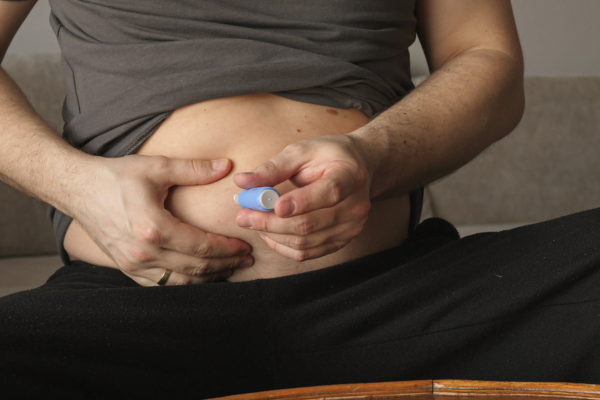Understanding Bydureon uses helps patients and clinicians align expectations. This weekly exenatide option can improve glucose control when diet and exercise are not enough. Below, you’ll find clear dosing guidance, device details, safety considerations, and current availability notes.
Key Takeaways
Bydureon uses include adjunct treatment for adults with type 2 diabetes. It works as a GLP‑1 receptor agonist (incretin-mimicking therapy) to lower glucose. Weekly dosing simplifies routines but still requires consistent technique and monitoring.
- Weekly GLP‑1 therapy: supports glucose control alongside lifestyle measures.
- Device specifics: extended-release microspheres explain injection-site nodules.
- Safety first: watch for GI effects and rare pancreatitis signs.
- Availability changes: check current supply and device status regularly.
- Switching therapies: coordinate timing and overlap with your clinician.
What Exenatide Is and How It Works
Exenatide is a GLP‑1 receptor agonist (incretin-mimicking drug) that enhances glucose-dependent insulin secretion. It also suppresses glucagon, slows gastric emptying, and can reduce appetite. These combined actions may lower A1C and support modest weight change in some patients.
Bydureon is the extended-release formulation of exenatide. Microspheres release medication slowly after subcutaneous injection, allowing once-weekly dosing. Immediate-release exenatide, marketed as Byetta, is given twice daily. For a broader class overview and positioning among peers, see GLP 1 Receptor Agonists Drugs, which summarizes options and indications.
For structural comparisons within the class, the Type 2 Diabetes category offers disease-focused context that situates incretin therapies among other first- and second-line treatments.
Bydureon uses and Indications
Bydureon is indicated as an adjunct to diet and exercise to improve glycemic control in adults with type 2 diabetes. It can be used alone or with other agents such as metformin or SGLT2 inhibitors, depending on individual goals and tolerability. It is not for type 1 diabetes or diabetic ketoacidosis.
Clinicians may select exenatide extended-release when once-weekly dosing fits patient routines. Consider renal function, gastrointestinal tolerability, and prior GLP‑1 experiences when choosing therapy. For a condensed orientation to benefits, cautions, and device basics, see Bydureon Uses Side Effects Dosage for a compact overview of the same therapeutic aims.
Dosage and Administration
The labeled strength for once-weekly exenatide extended release is 2 mg subcutaneously. This simple schedule may help adherence for people managing multiple medications. Clarify the injection day, rotate sites, and aim for consistent timing. If a weekly dose is missed, follow labeled timing guidance for catch-up, and avoid stacking doses within 72 hours.
Because the depot uses biodegradable microspheres, the suspension must be adequately mixed per device instructions. Technique matters: remove air bubbles, inject into subcutaneous tissue of the abdomen, thigh, or upper arm, and hold the device in place for the manufacturer-specified duration. Discuss the intended bydureon dose and device steps with your healthcare professional if any step is unclear. For context on where weekly injectables fit among other options, see Injectable Type 2 Diabetes Medications List, which outlines dosing and delivery differences.
Formulations, Devices, and Availability Basics
The current presentation has been an all-in-one autoinjector designed to simplify weekly administration. Historically, there was also a kit format and a predecessor pen device. Many regions no longer distribute earlier formats, so confirm exactly which product your pharmacy carries and request device training if you are new to it.
Patients and clinicians may still encounter references to bydureon bcise, the branded autoinjector for exenatide ER. In practice, you will see a single weekly strength, and instructions emphasize mixing and a steady needle hold. For a practical comparison with other branded incretin options, see Trulicity Vs Bydureon, which highlights device ergonomics and weekly-use differences relevant to training and adherence.
Safety Profile and Common Reactions
Gastrointestinal effects are the most frequent reactions. Nausea, vomiting, diarrhea, and decreased appetite often appear early and may lessen with continued use. Injection-site nodules and pruritus can occur due to the microsphere depot. Patients should report severe or persistent symptoms promptly.
Rare but serious events include pancreatitis symptoms (e.g., severe abdominal pain) and gallbladder complications. A boxed warning notes the risk of thyroid C‑cell tumors observed in rodents; avoid use in people with a personal or family history of medullary thyroid carcinoma or MEN2. For comprehensive risks and contraindications, consult the FDA-approved prescribing information, which details warnings and monitoring needs in the prescribing information. Discuss any bydureon injection side effects with your healthcare professional, especially if severe or unusual.
Weight and Metabolic Effects
Exenatide ER can reduce appetite and slow gastric emptying, which may support modest weight change in some adults with type 2 diabetes. However, it is not approved solely for weight management. Early GI effects can also influence intake, so hydration and small meals may help tolerate therapy during initiation.
People sometimes ask about bydureon for weight loss outside diabetes treatment. Off-label use in non-diabetic individuals is not established and may carry unnecessary risk. If weight management is a primary goal, consider GLP‑1 agents specifically studied for obesity and compare their evidence base and dosing. For program-level considerations and reported outcomes, see Bydureon Weight Loss, which summarizes observed effects and practical limits for this medication.
Access and Discontinuation Updates
Availability can change by country, device variant, and manufacturer supply. Pharmacies may alternate stock or experience intermittent backorders. Before starting, confirm product access and expected refill timelines, especially if coordinating insurance authorizations or prior therapy transitions.
Some markets report device transitions and phased withdrawals of older formats, and news of bydureon bcise discontinued status has circulated during supply realignments. Because supply status is time-sensitive, verify current information through official channels. The FDA Drug Shortages database provides periodically updated notes on shortages and resolutions; check the entry for exenatide extended release if listed on the Drug Shortages site. For a side-by-side view of alternatives if access tightens, see Ozempic Vs Bydureon, which compares dosing, efficacy endpoints, and device specifics.
Comparisons and Switching
Comparing across GLP‑1 agents helps align therapy with individual goals. Some agents emphasize A1C reduction, others highlight weight outcomes, while delivery systems and titration plans vary. Head-to-head differences can influence convenience, tolerability, and adherence over time.
When switching from bydureon to ozempic, clinicians typically coordinate the last weekly dose, the first new injection, and any washout to avoid overlapping effects. Because semaglutide uses a different titration schedule, individualized plans prevent over- or under-treatment during transition. For broader comparisons across incretins, see Bydureon Vs Victoza for daily-versus-weekly trade-offs, and Byetta Vs Bydureon for immediate- versus extended-release exenatide considerations. For dual-incretin perspectives and evolving data, Bydureon Vs Victoza and Trulicity Vs Bydureon together outline practical device and dosing contrasts patients often weigh.
Practical Use: Technique, Storage, and Missed Doses
Prepare the device as directed, mix until uniformly suspended, and complete the full injection with a steady hold. Rotate abdomen, thigh, or upper arm sites to reduce local reactions and lipodystrophy. Dispose of used devices in an approved sharps container. If a dose is missed, follow the label’s timing guidance and avoid doubling doses within the same 72-hour window.
Store the autoinjector refrigerated until use, then let it reach room temperature as instructed to improve comfort. Keep devices away from light and do not freeze. For users who want a consolidated refresher, Bydureon Uses Side Effects Dosage offers a succinct recap of steps and precautions. To understand where weekly exenatide sits among related incretins, Trulicity Vs Bydureon and Ozempic Vs Bydureon provide context that may influence training and device choice.
Who Should Use Caution or Avoid
Avoid use in people with a personal or family history of medullary thyroid carcinoma or in those with MEN2. Use caution in severe gastrointestinal disease, history of pancreatitis, or reduced kidney function where dehydration risk is higher. Discuss pregnancy, breastfeeding, or planned surgery timing with your healthcare professional.
Review current medications for potential overlap in gastrointestinal effects and hypoglycemia risk, especially when combined with insulin or sulfonylureas. Monitoring A1C, renal function, and tolerability helps confirm benefit. For high-level guidance on GLP‑1 use within diabetes care, the ADA Standards of Care provide consensus recommendations updated annually in the ADA Standards of Care.
Generic Status and Drug Class
Exenatide is the active ingredient across immediate- and extended-release forms. Branding, device type, and release profile distinguish products. Patents and exclusivities evolve, which may alter market options over time. Patients should verify the exact product on their prescription label, including device type and strength.
The bydureon generic name refers to exenatide, a GLP‑1 receptor agonist. Within this class, agents differ in molecular design, dosing frequency, and clinical emphasis. For readers exploring the wider incretin landscape and potential alternatives if supply tightens, start with GLP 1 Receptor Agonists Drugs for a structured list of available options and their core features.
Recap
Bydureon offers once-weekly exenatide with demonstrated glucose-lowering effects. Success depends on consistent injection technique, realistic expectations about GI tolerability, and regular monitoring. Availability can change, so confirm supply and plan transitions when needed.
For deeper comparisons and device nuances, consult Trulicity Vs Bydureon and Ozempic Vs Bydureon. If you need a concise refresher, Bydureon Uses Side Effects Dosage provides a compact summary. Always align therapy decisions with your clinician’s individualized plan.
Note: Device instructions can vary by country and lot. Always review the current patient information with each refill and ask your pharmacist to demonstrate any updated steps.
This content is for informational purposes only and is not a substitute for professional medical advice.



